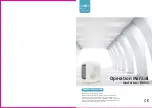
5 Preparation
Installer and user reference guide
12
RWEYQ8~1 RWEYQ8~14T9Y1B
VRV IV water-cooled system air conditioner
4P452191-1 – 2017.04
▪ In places where a mineral oil mist, spray or vapour may be
present in the atmosphere. Plastic parts may deteriorate and fall
off or cause water leakage.
NOTICE
This equipment is compliant with Class A of EN55032/
CISPR 32. In a residential environment this equipment
may cause radio interference.
NOTICE
The equipment described in this manual may cause
electronic noise generated from radio-frequency energy.
The equipment complies to specifications that are
designed to provide reasonable protection against such
interference. However, there is no guarantee that
interference will not occur in a particular installation.
It is therefore recommended to install the equipment and
electric wires keeping proper distances away from stereo
equipment, personal computers, etc.
b
c
f
d
d
a
c
b
e
(mm)
≥1500
≥1000
≥1000
≥1000≥1500
≥1500
≥1500
a
Personal computer or radio
b
Fuse
c
Earth leakage protector
d
User interface
e
Indoor unit
f
Outdoor unit
In places with weak reception, keep distances of 3 m or more to
avoid electromagnetic disturbance of other equipment and use
conduit tubes for power and transmission lines.
CAUTION
Appliance not accessible to the general public, install it in a
secured area, protected from easy access.
This unit, both indoor and outdoor, is suitable for
installation
in
a
commercial
and
light
industrial
environment.
▪ When installing, take strong winds, typhoons or earthquakes into
account, improper installation may result in the unit turning over.
▪ Take care that in the event of a water leak, water cannot cause
any damage to the installation space and surroundings.
▪ When installing the unit in a small room, take measures in order to
keep the refrigerant concentration from exceeding allowable
safety limits in the event of a refrigerant leak, refer to
safety against refrigerant leaks" on page 12
CAUTION
Excessive refrigerant concentrations in a closed room can
lead to oxygen deficiency.
▪ Ensure that water cannot cause any damage to the location by
adding water drains to the foundation and prevent water traps in
the construction.
▪ Install drain piping to ensure proper drainage and insulate piping
to prevent condensation. Improper drain piping may result in
indoor water leakage and property damage.
5.2.2
Securing safety against refrigerant leaks
About safety against refrigerant leaks
The installer and system specialist shall secure safety against
leakage according to local regulations or standards. The following
standards may be applicable if local regulations are not available.
This system uses R410A as refrigerant. R410A itself is an entirely
safe non-toxic, non-combustible refrigerant. Nevertheless care must
be taken to ensure that the system is installed in a room which is
sufficiently large. This assures that the maximum concentration level
of refrigerant gas is not exceeded, in the unlikely event of major leak
in the system and this in accordance to the local applicable
regulations and standards.
About the maximum concentration level
The maximum charge of refrigerant and the calculation of the
maximum concentration of refrigerant is directly related to the
humanly occupied space in to which it could leak.
The unit of measurement of the concentration is kg/m³ (the weight in
kg of the refrigerant gas in 1 m³ volume of the occupied space).
Compliance to the local applicable regulations and standards for the
maximum allowable concentration level is required.
According to the appropriate European Standard, the maximum
allowed concentration level of refrigerant to a humanly space for
R410A is limited to 0.44 kg/m³.
b
a
a
Direction of the refrigerant flow
b
Room where refrigerant leak has occurred (outflow of all
the refrigerant from the system)
Pay special attention to places such as basements etc., where
refrigerant can accumulate, since refrigerant is heavier than air.
To check the maximum concentration level
Check the maximum concentration level in accordance with steps 1
to 4 below and take whatever action is necessary to comply.
1
Calculate the amount of refrigerant (kg) charged to each system
separately.
Formula:
A+B=C
A
Amount of refrigerant in a single unit system (amount of
refrigerant with which the system is charged before leaving
the factory).
B
Additional charging amount (amount of refrigerant added
locally).
C
Total amount of refrigerant (kg) in the system.
NOTICE
Where a single refrigerant facility is divided into 2 entirely
independent refrigerant systems, use the amount of
refrigerant with which each separate system is charged.
2
Calculate the volume of the room (m³) where the indoor unit is
installed. In one of the following cases, calculate the volume of
(D), (E) as a single room or as the smallest room:













































